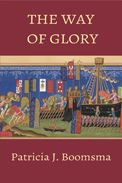
 |
Cate is almost at a marriageable age in twelfth-century England, but she would rather serve God than marry the old man her father has in mind. A group of men from her village plan to leave to fight in a crusade to save Jerusalem. Her brother is going as a priest, and her aunt is going to help cook for and tend the wounded. Cate decides to join them and help her aunt. It helps that the boy from the village who catches her eye is going as well.
This book gives a glimpse of what medieval life looked like for many women. There are religious themes as Cate and her aunt work at the convent. Cate’s brother struggles with getting men to live out their faith and leave the women at the ports alone. The men believe they are fighting a battle for the Lord. The role of women as being subservient to men is also explored in the fact that Cate’s father was arranging her marriage, and, later, she needs permission to leave the boat. Independent in spirit, she struggles with being told what to do all the time.
One of the overarching themes is trying to see through the prejudices of the time against Jews and Moors. Cate is one of the few who tries to see people as people. When a boy is found dead in her hometown, the local Jewish moneylender is thought to be the culprit, even though the facts prove otherwise. His shop is burned down anyway. When the soldiers have a prolonged stop in Hispania, Cate befriends a Moorish woman. Her divided loyalties may cost her more than she’s willing to give. In short, the author has penned an eye-opening and thought-provoking tale of a troubled time not frequently explored in literature.